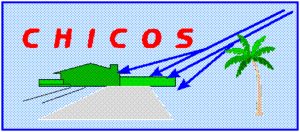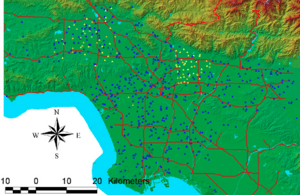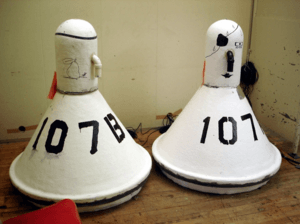CHICOS facts for kids
The California High School Cosmic Ray Observatory, known as CHICOS, is a huge science project. It's run by the Kellogg Laboratory at the California Institute of Technology in Pasadena, California. CHICOS is one of the biggest ongoing programs in the world that studies cosmic rays. It uses a large network of detectors, mostly found at high schools in the Los Angeles area. Some elementary and middle schools also have these special detectors.
Contents
What CHICOS Does
The CHICOS project mixes exciting scientific research with learning for students. CHICOS is actively looking for very powerful particles called Ultra-high-energy cosmic rays (UHECRs). These particles are incredibly strong. Imagine a brick falling from a rooftop – that's how much energy one tiny particle can have when it hits Earth!
When these UHECRs hit our atmosphere, they create big "showers" of smaller particles. These showers spread out over many square kilometers. To catch them, scientists need a huge "net" of sensors. CHICOS uses schools across Los Angeles as this "net." Schools have the space and also have teachers and students who help with the project.
Meet the Shmoos (Cosmic Ray Detectors)
The special detectors used in CHICOS are called "Shmoos." They got this name because they look a bit like the cartoon character, Shmoo! Most schools in the program have two of these Shmoos on their campus. They work together to collect accurate information about particle showers.
Shmoos are super important for the CHICOS project. Building them needs careful measurements and construction. They are usually built at the Kellogg Radiation Laboratory. Then, they are sent to schools. High school students sometimes get to help put these detectors together. Once the Shmoos are installed, teachers and students at the school help keep them working. The two Shmoos at a school are usually placed close to each other. They connect with cables to a computer that comes with the detectors.
The Future of CHICOS
CHICOS has a system that records all the big cosmic ray showers that hit its network. The information from detectors at different schools is combined. This helps scientists figure out where the cosmic rays came from. They use this data to create maps of the sky. These maps show the directions cosmic rays travel from outer space. Each shower recorded points to a cosmic event.
The main goal of CHICOS is to trace these cosmic rays back to their source. Scientists want to understand what exactly creates these super-powerful UHECRs. This is one of the biggest unsolved mysteries in physics today! In the future, more schools in Los Angeles will join the program. This means more data will be collected, and the sky-map will become even more complete. Studying CHICOS data and comparing it with astronomical research will help us better understand cosmic rays and the universe.
Who Supports CHICOS?
IBM gave many of the computers used at each school site to collect data. The National Science Foundation helps pay for the daily costs of running the project.
CHICOS is always looking for more support from public and private groups. This help allows them to grow the project and offer even better educational opportunities.





